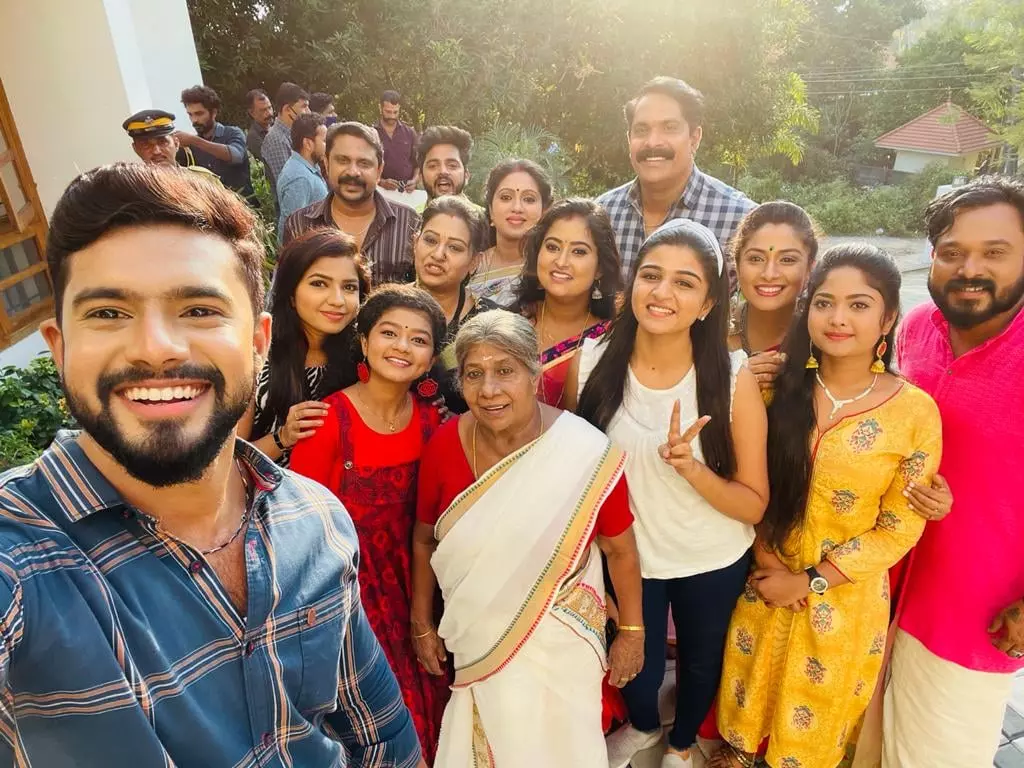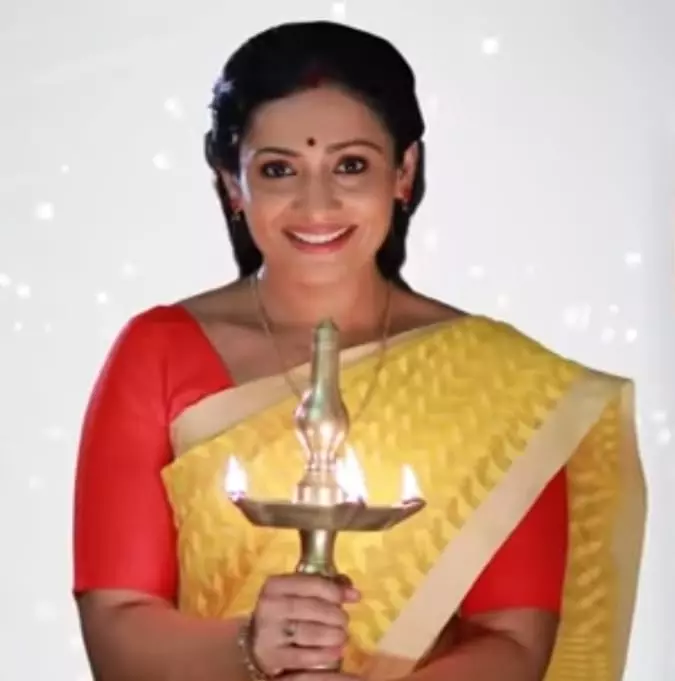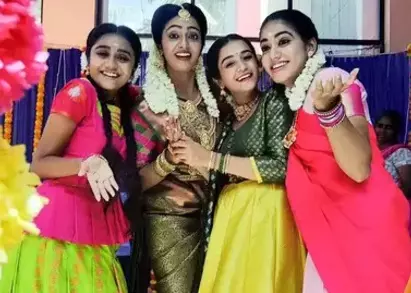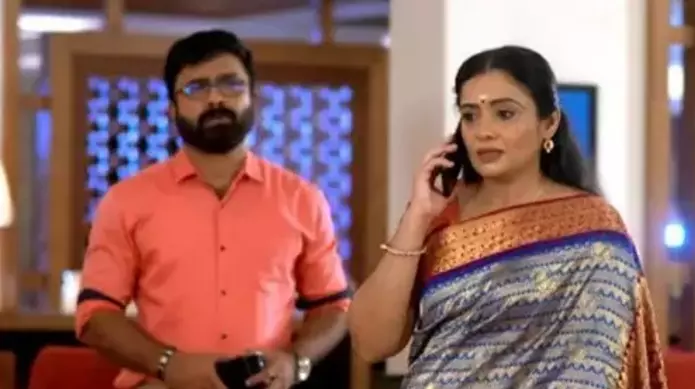
- Home
- India
- World
- Premium
- THE FEDERAL SPECIAL
- Analysis
- States
- Perspective
- Videos
- Sports
- Education
- Entertainment
- Elections
- Features
- Health
- Business
- Series
- In memoriam: Sheikh Mujibur Rahman
- Bishnoi's Men
- NEET TANGLE
- Economy Series
- Earth Day
- Kashmir’s Frozen Turbulence
- India@75
- The legend of Ramjanmabhoomi
- Liberalisation@30
- How to tame a dragon
- Celebrating biodiversity
- Farm Matters
- 50 days of solitude
- Bringing Migrants Home
- Budget 2020
- Jharkhand Votes
- The Federal Investigates
- The Federal Impact
- Vanishing Sand
- Gandhi @ 150
- Andhra Today
- Field report
- Operation Gulmarg
- Pandemic @1 Mn in India
- The Federal Year-End
- The Zero Year
- Science
- Brand studio
- Newsletter
- Elections 2024
- Events
Light, sound, camera... Endosulfan: What's making Malayalam TV serials toxic

concerns about the quality and content of Malayalam television serials are widespread.For Malayalis, Endosulfan is not just a word—it’s a haunting reminder of pain, injustice, and suffering—the most toxic imagination they could ever have. This toxic pesticide, once sprayed indiscriminately over the lush landscapes of Kasaragod, left behind a legacy of human suffering, deformities,...
concerns about the quality and content of Malayalam television serials are widespread.For Malayalis, Endosulfan is not just a word—it’s a haunting reminder of pain, injustice, and suffering—the most toxic imagination they could ever have. This toxic pesticide, once sprayed indiscriminately over the lush landscapes of Kasaragod, left behind a legacy of human suffering, deformities, and environmental devastation. The tragedy seeped into the collective psyche, transforming into a symbol of exploited innocence and a rallying cry for justice.
When someone equates something to Endosulfan, the impact is profound—evoking a deep, unsettling resonance. This was precisely the effect when Kerala State Chalachitra Academy’s acting chairman, actor Premkumar, likened Malayalam soap opera-style television serials to the notorious pesticide. His sharp critique came during a press conference in Kochi, where he was elaborating on the upcoming International Film Festival of Kerala (IFFK). Premkumar’s comparison struck a nerve, setting off a debate about the cultural and artistic impact of these serials.
“I am not saying all serials are alike and insulting them. I am someone who wants an artiste to have unrestricted freedom of expression. There is censorship in cinema, but not for television serials. There are practical problems with that. Those in the industry say that scenes shot will be telecast on the same day. There is no time for censorship in that gap,” said Premkumar.
Premkumar’s critique unsurprisingly sparked a backlash from the television fraternity. The Association of Television Media Artists (ATMA) responded with sharp criticism, led by its president, actor-politician, and Kerala's Transport Minister, KB Ganeshkumar. He demanded an apology, asserting that Premkumar’s remarks were unwarranted and disparaged an entire creative industry. The controversy has since snowballed, drawing attention to the simmering tensions between the film and television worlds.
The crux of the issue is that concerns about the quality and content of Malayalam television serials are widespread. Critics argue that these shows often lean heavily on regressive themes, failing to reflect the progressive cultural identity Kerala prides itself on. While Premkumar’s remarks may have been incendiary, they have reignited a crucial conversation about the role of serials in shaping societal values. This ongoing debate underscores a shared frustration: the need for television content that resonates with Kerala’s evolving ethos rather than anchoring it to outdated stereotypes.
It's an undeniable fact that apart from news channels, Malayalam general entertainment television is dominated by serials. From 7 pm to 11 pm, viewers are bombarded with 30 to 40 serial episodes across channels, all weaving tales of exaggerated, melodramatic, and often unrealistic family drama. These serials have carved out a significant share of prime time, but their repetitive and shallow narratives have raised concerns about their cultural and creative value.
Critics worry that this deluge of content caters more to sensationalism than meaningful storytelling, overshadowing the potential for television to contribute something meaningful.
When TV characters turn companions
For 70-year-old Sarada Devi, a retired nursing superintendent, the characters of her favourite serials are more than fictional—they’re companions woven into the fabric of her daily life. Sarada now resides with her unmarried journalist daughter, whose “serious life” she admires but doesn’t entirely relate to. On a three-month visit to her daughter’s home, Sarada finds herself grappling with frustration and restlessness. The reason? Her beloved serials are missing from her routine. Without a cable TV connection and unfamiliar with modern gadgets like Firestick, Sarada found herself at odds with her daughter’s tech-savvy lifestyle, leading to unnecessary quarrels. Finally, as a compromise, her daughter subscribed to multiple OTT platforms, allowing Sarada to watch her cherished soaps on her phone.

The cast of Mounaragam, a Malayali TV soap.
“It’s hard to break off the routine of being with them—the characters of the serials—daily,” Sarada admits with a hint of embarrassment. “I know it’s kind of absurd, but my day doesn’t feel complete without watching them. I can’t sleep, really.” For Sarada, these serials are more than entertainment; they are an anchor, providing comfort and continuity in a life otherwise uprooted from its familiar rhythm.
***
The clock strikes 6 am, and Vanaja steps out into the waking streets of Kochi, her day already in motion. Three apartments await her tireless hands and quiet efficiency, a rhythm she’s perfected over years. By evening, she returns home, the weight of the day eased by her daughter-in-law’s completed chores. But Vanaja's true respite begins at 7 pm. With the click of a remote, her world transforms. For three uninterrupted hours, the strains of reality fade into the vivid, melodramatic universe of her beloved serials. The stories blur, their details elusive, but their purpose is clear—offering her solace in a life filled with uncertainties.
In the expansive realm of televised dramas, Sarada Devi and Vanaja represent countless women who find comfort in the repetitive tales of strained relationships, divorces, extramarital affairs, and intricate family dynamics. Predominantly set in upper-caste Hindu households, these serials often feature astrologers and even Hindu deities stepping in to untangle the characters’ dilemmas. From age-old clashes between mothers-in-law and daughters-in-law to stepmothers mistreating children, these familiar storylines strike a chord with viewers like Sarada and Vanaja, offering a sense of solace and the hope of resolution. Despite their predictability, these narratives forge an emotional connection that transcends the screen, becoming an essential refuge for many navigating life's uncertainties.

A still from Kudumbavilakku
In the expansive realm of televised dramas, Sarada Devi and Vanaja represent countless women who find comfort in the repetitive tales of strained relationships, divorces, extramarital affairs, and intricate family dynamics. Predominantly set in upper-caste Hindu households, these serials often feature astrologers and even Hindu deities stepping in to untangle the characters’ dilemmas. From age-old clashes between mothers-in-law and daughters-in-law to stepmothers mistreating children, these familiar storylines strike a chord with viewers like Sarada and Vanaja, offering a sense of solace and the hope of resolution. Despite their predictability, these narratives forge an emotional connection that transcends the screen, becoming an essential refuge for many navigating life's uncertainties.
“My mother-in-law is a staunch leftist—she votes for the Communist Party, and her family has deep roots in the movement, with her uncle even being a party leader of sorts. But these days, she’s completely engrossed in serials, and, surprisingly, she’s started talking about religion and things that were once alien to our household,” says M Geetanjali, a concerned school teacher and activist with the Kerala State Teachers Association. “Her exposure to these ideas comes entirely from the serials. It’s no wonder that right-wing ideology is creeping into Kerala’s social fabric so quickly,” she added, reflecting on the shifting dynamics in the state.
Commercial gain over artistic integrity
“Television serials have turned into a centralised project, stripping writers of the freedom to choose their own stories and craft scripts accordingly,” remarks K Girish Kumar, an award-winning screenwriter who has successfully transitioned from serials to cinema. He points out that most major Malayalam mega serials are remakes or adaptations of shows from Hindi or Bengali television.
Gireesh Kumar, the writer behind the serial Anna, which aired in 2001 and was adapted from the Russian classic Anna Karenina, has been a steadfast advocate for a complete reform and the introduction of a fresh television language in Malayalam general entertainment content.
However, the industry has plunged into a significant decline in quality, relying on tired plots, over-the-top melodrama, and repetitive storylines predominantly featuring upper-caste Hindu settings. This trend has resulted in a sameness of themes and characters that stifles creativity and fresh ideas. To cut the long story short, the relentless chase for higher ratings and commercial gain has compromised artistic integrity, placing profit ahead of genuine creative expression.
In the late eighties and early nineties, the television landscape was dominated by 13-episode serials that underwent rigorous scrutiny during the Doordarshan era, a system that somehow ensured a certain level of quality in the content. Initially, private channels adhered to this format as well. However, at the dawn of the millennium, the scene shifted dramatically with the emergence of mega serials featuring hundreds of episodes, marking a turning point that is yet to see a return to the previous standards.
“The Kerala State Television award jury stopped selecting the best serial for award a few years ago. None of the popular serials in Malayalam has a story that has any cultural connection with Kerala. It is not because of scarcity of good writers, actors, or directors. It is because the commercial interest does not match with the quality requirements,” explains Ganesh Olikkara, a scriptwriter who has contributed to several mega serials in Malayalam.

Concerns about the quality and content of Malayalam television serials are widespread.
A look at the ongoing and recently concluded serials reveals the quality crisis affecting the industry. Kudumbavilakku, currently airing on Asianet and available for streaming on Disney+ Hotstar, is notable for being one of the longest-running soap operas in Malayalam. A remake of the Bengali serial Sreemoyi, it tells the story of Sumitra Menon, a devoted Malayali homemaker portrayed as the ideal daughter-in-law who endures mistreatment and discrimination with a constant smile. The synopsis of the serial reads like this: A woman does not get a moment of rest while doing all the household chores on top of being a dutiful wife, daughter-in-law and mother. Yet, she is never acknowledged or appreciated for her work.
Since its premiere on January 27, 2020, the show has aired over 1,003 episodes, concluding on December 1, 2023, only to be immediately followed by a second season that started on December 4 and has run past 1200 episodes. Notably, Sreemoyi has been adapted into six languages—Kannada, Tamil, Odia, Hindi, Telugu, and Marathi—with each version featuring a similar narrative but different cast, broadcast on channels owned by Star TV.
Scriptwriters and directors in the television industry assert that the centralisation of production is the main reason for the decline in quality. “The production company determines the storyline. Major companies like Star and ZEE TV follow a single narrative thread across all languages. Writers are handed these storylines—often based on Hindi or Bengali serials—and instructed to write. As a result, these narratives often fail to connect with the local culture, leaving little room for innovation,” explains Ganesh, who is currently scripting a Malayalam mega serial adapted from the Hindi series Iss Pyar Ko Kya Naam Doon, which aired on Star Plus in 2011-12.
“In serials, you can only see people who commit cruelty, mothers-in-law who hate daughters-in-law, stepmothers harassing children—all placed in contrast to the super good, ideal, patient protagonist woman. Characters are put in negative shade to enhance the contrast and thus melodrama which conveys very harmful ideas about family and society,” says Madhupal, actor and award-winning Malayalam director who served as the chairman of the Jury for the State Television Award in 2019.
Light, sound, camera… Hindutva
Those involved in television serials generally concur that these shows often propagate superstitions and subtly promote Hindutva ideology. A recurring theme in many serials is the presence of an astrologer who offers solutions to various problems. In a contemporary serial, a boy appears and speaks to the head of the family, providing guidance during a crisis. Enlightened by the boy's advice, the man goes to fetch his wife to meet him. However, by the time she returns, the boy has mysteriously vanished, implying that he represents Lord Krishna.
“You cannot find a single-family drama set in the backdrop of a Christian or Muslim family. This is a major shift that happened to the popular fiction culture in Kerala,” says Madhupal.

The Malayalam TV industry has plunged into a significant decline in quality, relying on tired plots, over-the-top melodrama, and repetitive storylines predominantly featuring upper-caste Hindu settings.
Serials consistently adhere to the good woman-bad woman binary archetype. Writers crafting these stories note that the plots are often quite similar, featuring a set of essential evil characters who torment the ‘good woman’—the pious, chaste, and obedient protagonist. Unlike in cinema, where male leads often take centre stage, television serials primarily focus on female characters, showcasing both the virtuous and the villainous, creating a stark contrast between the two.
"The serial makers know exactly who their audience is—mostly grandmothers and mothers. They think that whatever nonsense they throw at them will be happily accepted. It's not about art for them; TRP ratings are everything. You can't really blame anyone. If someone has a good story or a creative idea, they always want to make it into a film, where there's more money and recognition. They never see serials as a serious option," opines Manju Hariharan a film student based in Kochi.
"Serials mostly target the working-class people, but it does not mean that the upper class are free from the serial menace," asserts Madhupal. There is a widely shared perception that women are the primary audience for these soap operas, while men prefer current affairs and news. However, Madhupal challenges this notion, stating, "It might be true that a large chunk of the viewers are women, but men also love to watch serials. I have heard men discussing the serial stories."
Malayalam cinema has seen considerable growth in quality, with the lines between art house and commercial films becoming increasingly blurred. Unlike serials, which prioritize TRP ratings over quality, Malayalam cinema has earned acclaim for delivering box office successes while maintaining artistic integrity. Madhupal points out the difference in audience engagement, emphasizing that cinema is often enjoyed as a collective family experience, whereas serials are typically watched alone in living rooms.
"People can choose cinema and prioritize quality as they often watch it with their entire family. In contrast, people have limited options when it comes to serials," explains Madhupal.
“I believe the current trend of adapted serials will soon come to an end. Young people aren’t interested in them. These serials primarily attract viewers over fifty and women who have limited opportunities for other activities,” remarks Ganesh. However, not all writers agree with this viewpoint. “It’s difficult to predict the future of serials, as today’s young viewers will eventually grow older and find themselves in the living room with little mobility. There will always be soap operas waiting for them,” counters Madhupal.
"Television serials are reaching the family audience. Children who grow up in the habit of watching these scenes will think that this is life and this is what human relationships are. I share my concern about the generation that has such a vision. Those who do a work of art should have that responsibility," clarifies Prem Kumar about his Endosulfan remark on the serials.
The discussion initiated by Premkumar appears to be diverging, with the serial artists and their association perceiving it as a threat to their livelihoods. However, they remain silent on the regressive content itself and instead shift the blame to the TV stations that produce this content, primarily sourced from Hindi and other languages. Critics are also raising concerns about this, as the content often undermines the cultural and progressive values that the state has worked to achieve, particularly citing the adverse political impact that Hindi serials from the late eighties had on our polity. These shows often reinforced traditional stereotypes and ideologies, shaping public perceptions and influencing political discourse in ways that contributed to a regression in societal values.
